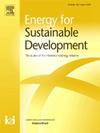Techno-economic assessment on the cost-effective manufacture of scaled-up VRFB system - An Indian scenario
IF 4.9
2区 工程技术
Q2 ENERGY & FUELS
引用次数: 0
Abstract
Vanadium redox flow battery (VRFB) is one of the promising contenders in battery energy storage systems (BESS). India is the third largest producer and consumer of electricity, with aspirations to increase its contributions from renewable energy sources. This study focuses on the techno-economic analysis of the VRFB system in the Indian context. This approach allows for a comparison of system costs in the Indian context with global trends. This work identifies the levelized cost of storage (LCOS) for a 5 kW / 10 kWh VRFB system and compares it against prevailing information in the global market. The analysis shows that the calculated LCOS value of 0.78 $ kWh−1 cycle−1 is approximately 29 % higher than the prevailing global LCOS value of 0.54 $ kWh−1 cycle−1 and far behind the target figure laid down by the US Department of Energy (DOE). The parameters affecting the LCOS are examined through sensitivity analysis, and the dominant factor for the capital costs is identified in an effort towards minimizing the LCOS, which shows a 4.8 % variation for a 10 % change. The high capital cost components, such as membrane and electrolyte, are critically examined and evaluated using indigenously developed components in a single cell for understanding the performance metrics. Additionally, the graphite plates and felt are analysed similarly as above for further cost reduction. An optimal combination of key materials and components determined through orthogonal analysis, achieving a lowest LCOS of 0.46 $ kWh−1 cycle−1. This analysis provides new insights into furthering the cost reduction measures for the manufacture of the VRFB system and moving towards the coveted golden LCOS target of DOE.
规模化VRFB系统成本效益的技术经济评估——以印度为例
钒氧化还原液流电池(VRFB)是电池储能系统(BESS)中很有前途的竞争者之一。印度是第三大电力生产国和消费国,希望增加可再生能源的贡献。本研究的重点是印度VRFB系统的技术经济分析。这种方法可以将印度的系统成本与全球趋势进行比较。这项工作确定了5千瓦/ 10千瓦时VRFB系统的平准化存储成本(LCOS),并将其与全球市场的现行信息进行了比较。分析表明,计算出的LCOS值为0.78 $ kWh−1 cycle−1,比目前全球流行的LCOS值0.54 $ kWh−1 cycle−1高出约29%,远远落后于美国能源部(DOE)制定的目标数字。通过敏感性分析检查了影响LCOS的参数,并确定了资本成本的主要因素,以尽量减少LCOS,这表明10%的变化导致4.8%的变化。对于高投资成本的组件,如膜和电解质,在单个电池中使用自主开发的组件进行严格检查和评估,以了解性能指标。此外,为了进一步降低成本,对石墨板和毛毡进行了类似的分析。通过正交分析确定了关键材料和组分的最佳组合,LCOS最低为0.46 $ kWh−1 cycle−1。这一分析为进一步降低VRFB系统制造成本的措施以及向美国能源部梦寐以求的黄金LCOS目标迈进提供了新的见解。
本文章由计算机程序翻译,如有差异,请以英文原文为准。
求助全文
约1分钟内获得全文
求助全文
来源期刊

Energy for Sustainable Development
ENERGY & FUELS-ENERGY & FUELS
CiteScore
8.10
自引率
9.10%
发文量
187
审稿时长
6-12 weeks
期刊介绍:
Published on behalf of the International Energy Initiative, Energy for Sustainable Development is the journal for decision makers, managers, consultants, policy makers, planners and researchers in both government and non-government organizations. It publishes original research and reviews about energy in developing countries, sustainable development, energy resources, technologies, policies and interactions.
 求助内容:
求助内容: 应助结果提醒方式:
应助结果提醒方式:


